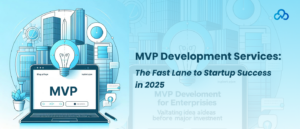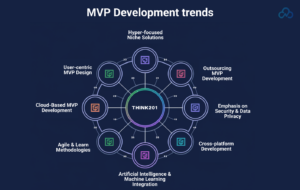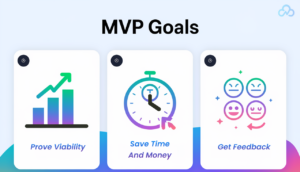MVP Development Services: The Fast Lane to Startup Success in 2025

In the world of startups, being fast and flexible is usually what separates success from never being heard of. Since situations in the market evolve rapidly and users’ expectations rise fast, businesses must be able to test, learn and adjust quickly. If founders follow the old way of building products, their business might be doomed before it can take off. That is why using MVP product development is becoming so valuable today.
A good way to successfully handle this demanding situation is to develop a Minimum Viable Product (MVP). An MVP helps startups introduce their product quickly, find out what users think and make improvements—without investing a lot in unreliable features. Whatever your stage in building or funding your startup, choosing MVP development services can help you get the expansion you need.
In 2025, there are more risks as people mainly innovate with AI, rely on simple no-code tools and face a lot of competition. Building an MVP gives you better chances of saving time and money, faster proof of product success, investment interest and a roadmap made with users in mind.
It looks into MVPs from several sides, explains why they are so crucial, explains the process for developing one and guides in finding the best agency. If you’re beginning to think about your business or ready to build it, using these principles will help you succeed fast.
What is an MVP and Why Does It Matter in 2025?
An MVP should have the bare minimum needed to entice some users and confirm your business idea. In contrast to laboring for years on a flawless product, an MVP means startups can quickly test their ideas, check user input and improve over time according to demand in the market.
In 2025, the market for startups is fiercer, as AI, blockchain and automation ensure things are more even for all companies. Because of these conditions, developing an MVP is something companies must do.
Why MVPs Are Crucial Today:
-
Get your product out first to win customers before your rivals.
-
Risk is lowered when you avoid building more assets than are needed.
-
Before pursuing your idea, make sure that solving the problem is important to customers.
-
Make sure your company has seen some activity and sales before you request funding.
Trends Driving MVP Product Development in 2025
Several trends are influencing how startups approach MVPs in 2025:
1. AI refers to Artificial Intelligence and Automation describes using robotic systems.
AI is now integrated into every part of modern MVP development, whether it’s in how users interact or in how the app’s background functions. AI makes it simpler to create and test the MVP.
2. No-Code/Low-Code Tools
Many startups are now building the first versions of their products in days with no-code and low-code software, making the process much cheaper.
3. User-Centric Design
In the future, how much a customer likes doing business with a company will matter the most. Now, an MVP needs user experience that improves user flow without any hiccups.
4. Microservices Architecture
MVPs are being constructed to be scalable, so updates and extra features can be added quickly after launch.
How to Develop an MVP: A Step-by-Step Guide

If you’re wondering how to develop an MVP, follow these essential steps to build something that resonates with users and scales efficiently.
1. Outline what the problem is.
Make sure you clearly understand the issue your product helps to address. Examine and analyze the market along with your competitors.
2. Build the profiles of your users.
Learn about the people using your product first. Make user personas to check that the MVP is helpful to real users.
3. Write down the main features of your applications.
Remove all parts of your product that are not basic, central or important. What basic functions does your product have to serve its users?
4. Make Sketches or Prototypes
It is good practice to use wireframes before writing any code to plan out both the steps and key features the user will see.
5. Focus on making your core product and release it as an MVP.
We’re ready to construct our project now. A lot of startups let agencies with MVP development skills take care of this, so they can have quick, scalable MVPs focused on users.
6. Publish your site and ask people for their thoughts.
Roll out your MVP to a group of users that you have chosen beforehand. Take what they tell you about the game to help shape the upcoming development.
7. Go through development repeatedly and expand the product.
Based on the information you collect, update and change the features, user experience and ability to scale.
Why Use MVP Development Services?
The option to design a MVP within the company is available, but it is often a better idea to outsource that work to experienced MVP developers. An MVP is built using technical knowledge and knowledge of the market, the behavior of users and how to develop quickly. If you choose to work with talented agencies, you greatly improve your chances of being successful.
1. How Fast They Work
Agencies that build MVPs have improved their methods with every project and new industry. By depending on tried-and-true tools, frameworks and techniques, they manage to deliver finished projects faster and more effectively than most teams inside a company. Startups in the year 2025 must get products to market quickly, since a slight delay can cause a new product to fail.
2. A strong background in MVP Product Development
The best MVP development agencies are equipped to help launch products in their initial phase. They are aware of what is most important and what to avoid to avoid slowing down development or spending more money. Because of their background, your MVP will not just add value for your users, but also allow for future growth and changes.
3. Cross-Functional Teams
Coding is only part of what it means to create an MVP. This means working on research, design, user experience, coding the back and front parts of an app, quality assurance and occasionally providing marketing advice. An MVP agency puts together a team with all the necessary skills to work closely and deliver a cohesive product. A blended approach means you don’t have to handle different vendors and can keep all communication under control.
4. Post-MVP Support
Creating an MVP is only the start of what you do. Many agencies can help you update your product as users provide feedback, add extra features and ensure your product grows successfully. As a result, your business will keep improving after launching, rather than stalling, until you achieve successful results and growth.
What to Look for in MVP Development Agencies
Not all agencies are created equal. When choosing an MVP partner, look for the following:
1. Startup-Focused Portfolio
Have other startups reaped success with their MVPs because of this agency?
2. Agile Methodology
MVP product development requires a lot of agility. Try to find teams that change their approach when given outside feedback.
3. Transparent Pricing
Choose a service that offers a set price for the MVP or bills according to how much time it takes to save your money.
4. End-to-End Services
Top MVP development agencies help from the start of an idea up until the product grows.
5. Able to Create Models Quickly
At the essence of what we do, speed counts most. Choose agencies that can take your ideas and build prototypes within a few weeks.
Common Mistakes to Avoid in MVP Development
Even with a solid plan, mistakes can derail your MVP. Watch out for these common pitfalls:
1. Overbuilding
Often, startups attempt to release their products filled with many different features. Just concentrate on the essential features.
2. Eventually deciding against user testing
Successful implementation of an MVP depends greatly on what users tell you. Before launch, get real feedback from your customers.
3. Poor UX/UI
A simple minimal viable product must have a clean and logical design.
4. Ignoring Scalability
Although you’re focusing on a small model now, anticipate the business’s bigger possibilities.
Case Study: How an MVP Helped a Startup Go from Idea to Investment
Let’s look at a real-world example:
Company: HealthSync (2024–2025)
Problem: Keeping track of their own dosages and getting messages to medical teams was not easy for patients.
HealthSync: created an MVP that gave alerts to users and allowed messages to be sent and seen by both users and doctors.
Results:
-
we worked with a MVP development agency and produced our minimum viable product within six weeks.
-
5,000 people became users in the past 3 months.
-
Got seed funding for $2.2 million.
Taking advantage of the key features of their app and listening to real users made HealthSync grow fast after the minimum viable product stage.
The Role of MVP Development in Securing Funding
In 2025, more investors pay attention to numbers than ever before. An MVP helps you accomplish the following:
-
Evidence of market interest during the early stages.
-
Customer feedback as well as the way the product is actually being used.
-
A team can speed up its investor readiness with a practical demo and a plotted, transparent plan of action.
A proven MVP and real user insights give your pitch real-world facts which helps raise funds more easily.
Future-Proofing Your MVP in 2025
What we call MVPs now is much more valuable, because they are both viable and scalable. How can you ensure your MVP remains up-to-date?
-
Design your application using Microservices.
-
Build your applications to work well in the cloud so you can easily scale them.
-
Use analytics tools as soon as you start developing your plan.
-
Do not rush integrating AI and automation until your product is fully matured.
Thinking about the future now helps you prevent having to adjust everything later on.
Choosing Between In-House vs Outsourcing MVP Development
When It Makes Sense to Build Engineering In-House
-
You have an IT co-founder or programmers in your own company.
-
You have to manage the process entirely.
-
You’re creating a product that is designed for a tight niche.
Reasons for Choosing Outsourcing:
-
You need to focus on getting up and running quickly with only the important costs.
-
You don’t have the necessary technical skills within your team.
-
It is essential to have a team including members from different areas from day one.
Most startups in 2025 will do well to look for experienced MVP development companies in the market.
FAQs
1. What is MVP product development and why is it important for startups in 2025?
Building an MVP means creating a basic product with only the main features so you can see if your service or product works well in the market and learn from its users. By 2025, businesses need to ensure they don’t take big risks, reduce the time to launch and verify their ideas before starting major work
2. How do I choose the right MVP development agency for my startup?
Do not hire an agency until it has strong references from startups, proven methods, fixed and clear prices and organizes design, development and testing together. Modern tools such as AI and microservices and quick prototyping are also main signs of a quality agency.
3. What are the main steps involved in developing an MVP?
To develop an MVP, you should:
-
State what issue your product helps to solve.
-
Decide which type of users your app is for and what are its key features.
-
Make development tools such as wireframes or prototypes.
-
Set up the basic version of your product together with your agency.
-
Let the early users try it and provide comments.
-
Adjust the solution and expand it after users begin using it.
4. Can building an MVP help secure startup funding?
Absolutely, a properly developed MVP will attract real users, confirm your idea’s market potential and measure progress—helping you gain the trust of investors. In 2025, companies looking for investment look for startups that are advancing and have found a strong match between their product and the market which can be proven with MVPs.
Conclusion: MVP Product Development Is the Startup Superpower of 2025
To bring about a fintech revolution or make life easier for remote teams, creating an MVP product gets you there most efficiently. You can speed up discovering lessons, work with a small budget, assess your customer community and find willing investors—all without overdoing it.
Thanks to the expertise of these agencies, any founder, regardless of technical skills, can bring a good product to market quickly. Now that you have accessible tools, frameworks and a focus on users, 2025 makes it better than ever to build smart, slim and scalable MVPs.
Should you have a product idea in 2025, don’t worry about making it perfect. Get a small project off the ground, move quicker and continue to fix and improve as you go. Developing an MVP is your direct path to making your startup successful.
Do you like to read more educational content? Read our blogs at Cloudastra Technologies or contact us for business enquiry at Cloudastra Contact Us